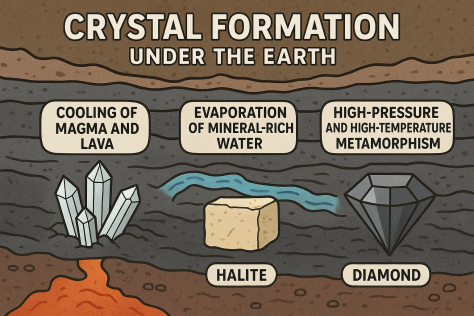
Deep beneath our feet, in places untouched by sunlight, nature works with the precision of a master craftsman. Over thousands, even millions, of years, the Earth’s heat, pressure, and chemistry transform minerals into breathtaking crystals. From sparkling quartz to dazzling diamonds, these natural wonders tell a story written in stone — a story of patience, pressure, and perfection.
What Are Crystals?
Crystals are solid materials whose atoms are arranged in an orderly, repeating pattern. This structure gives them their unique shapes, flat faces, and sharp edges. Unlike random solids, crystals grow in predictable ways, determined by their crystal lattice — the specific arrangement of their atoms.
How Crystals Form Beneath the Earth
Crystal formation underground follows a process called crystallization, which can occur in several ways:
1. Cooling of Magma and Lava
-
Process: When molten rock (magma) slowly cools deep underground, atoms have time to arrange into large, well-defined crystals.
-
Example: Quartz, feldspar, and mica in granite form this way.
-
Key Factor: Slow cooling → larger crystals.
2. Evaporation of Mineral-Rich Water
-
Process: Underground water can carry dissolved minerals. When the water evaporates or cools, minerals crystallize out of solution.
-
Example: Gypsum and halite (rock salt).
-
Key Factor: Water chemistry and evaporation rate.
3. High-Pressure and High-Temperature Metamorphism
-
Process: Existing rocks buried deep in the Earth experience intense pressure and heat, reorganizing atoms into new crystal structures without melting.
-
Example: Graphite turning into diamond.
-
Key Factor: Extreme depth and geologic forces.
Conditions Required for Crystal Growth
-
Temperature: Higher temperatures allow atoms to move freely and arrange into crystals.
-
Pressure: High pressure can change the arrangement of atoms, producing different minerals.
-
Time: The slower the growth, the more perfect the crystal.
-
Space: Crystals need open space to develop their characteristic shapes.
Famous Underground Crystal Formations
1. Naica Mine, Mexico
-
Known for its Giant Crystal Cave, hosting selenite crystals up to 12 meters long.
-
Formed in hot, mineral-rich water over hundreds of thousands of years.
2. Kimberlite Pipes, Africa
-
These deep volcanic structures carry diamonds from the mantle to the surface.
Why Studying Crystals Matters
Crystals are more than just beautiful; they are time capsules of Earth’s history. Their composition reveals past temperatures, pressures, and even the chemistry of ancient waters. Beyond geology, crystals have technological uses — from quartz in watches to silicon in electronics.
Final Thought
The next time you admire a shimmering gemstone or a chunk of quartz, remember: it was forged in the depths of the Earth, shaped by forces older and more patient than any human hand. Crystals are not just minerals; they are Earth’s slow, deliberate art.

Comments (0)
To comment, please Login